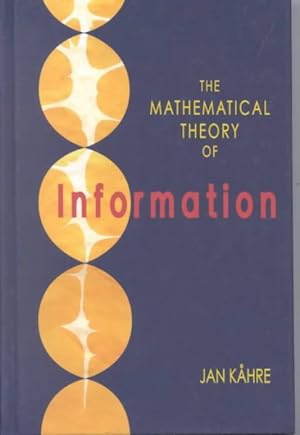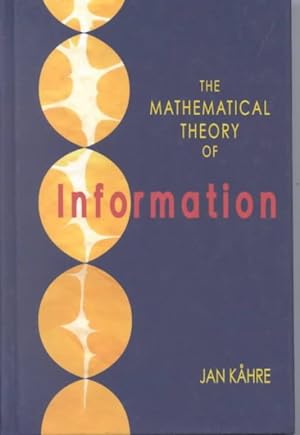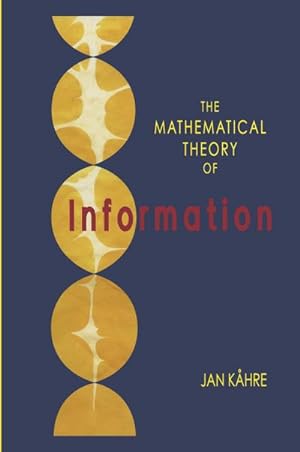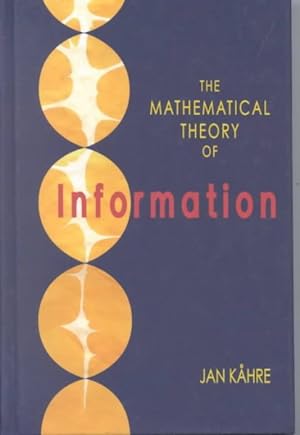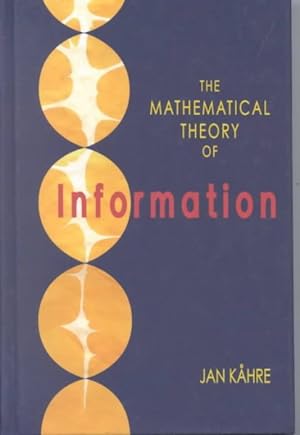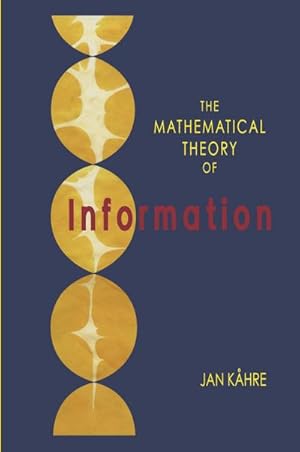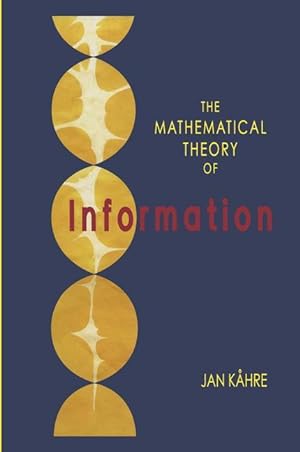mathematical theory information de kåhre jan (26 résultats)
Filtres de recherche
Type d'article
- Tous les types de produits
- Livres (26)
- Magazines & Périodiques (Aucun autre résultat ne correspond à ces critères)
- Bandes dessinées (Aucun autre résultat ne correspond à ces critères)
- Partitions de musique (Aucun autre résultat ne correspond à ces critères)
- Art, Affiches et Gravures (Aucun autre résultat ne correspond à ces critères)
- Photographies (Aucun autre résultat ne correspond à ces critères)
- Cartes (Aucun autre résultat ne correspond à ces critères)
- Manuscrits & Papiers anciens (Aucun autre résultat ne correspond à ces critères)
Etat En savoir plus
- Neuf (23)
- Comme neuf, Très bon ou Bon (3)
- Assez bon ou satisfaisant (Aucun autre résultat ne correspond à ces critères)
- Moyen ou mauvais (Aucun autre résultat ne correspond à ces critères)
- Conformément à la description (Aucun autre résultat ne correspond à ces critères)
Particularités
- Ed. originale (Aucun autre résultat ne correspond à ces critères)
- Signé (Aucun autre résultat ne correspond à ces critères)
- Jaquette (Aucun autre résultat ne correspond à ces critères)
- Avec images (16)
- Sans impressions à la demande (18)
Langue (1)
Prix
- Tous les prix
- Moins de EUR 20 (Aucun autre résultat ne correspond à ces critères)
- EUR 20 à EUR 45 (Aucun autre résultat ne correspond à ces critères)
- Plus de EUR 45
Livraison gratuite
Pays
Evaluation du vendeur
-
EUR 54,48
Autre deviseEUR 2,27 expédition vers Etats-UnisQuantité disponible : Plus de 20 disponibles
Ajouter au panierEtat : New.
-
The Mathematical Theory of Information (The Springer International Series in Engineering and Computer Science, 684)
Vendeur : Lucky's Textbooks, Dallas, TX, Etats-Unis
EUR 53,30
Autre deviseEUR 3,42 expédition vers Etats-UnisQuantité disponible : Plus de 20 disponibles
Ajouter au panierEtat : New.
-
The Mathematical Theory of Information (The Springer International Series in Engineering and Computer Science)
Vendeur : Lucky's Textbooks, Dallas, TX, Etats-Unis
EUR 57,62
Autre deviseEUR 3,42 expédition vers Etats-UnisQuantité disponible : Plus de 20 disponibles
Ajouter au panierEtat : New.
-
The Mathematical Theory of Information (The Springer International Series in Engineering and Computer Science)
Vendeur : Ria Christie Collections, Uxbridge, Royaume-Uni
EUR 57,94
Autre deviseEUR 13,72 expédition depuis Royaume-Uni vers Etats-UnisQuantité disponible : Plus de 20 disponibles
Ajouter au panierEtat : New. In.
-
The Mathematical Theory of Information (The Springer International Series in Engineering and Computer Science, 684)
Vendeur : Ria Christie Collections, Uxbridge, Royaume-Uni
EUR 57,94
Autre deviseEUR 13,72 expédition depuis Royaume-Uni vers Etats-UnisQuantité disponible : Plus de 20 disponibles
Ajouter au panierEtat : New. In.
-
EUR 57,93
Autre deviseEUR 17,18 expédition depuis Royaume-Uni vers Etats-UnisQuantité disponible : Plus de 20 disponibles
Ajouter au panierEtat : New.
-
The Mathematical Theory of Information
Edité par Kluwer Academic Publishers, US, 2002
ISBN 10 : 1402070640 ISBN 13 : 9781402070648
Langue: anglais
Vendeur : Rarewaves.com USA, London, LONDO, Royaume-Uni
EUR 81,73
Autre deviseGratuit expédition depuis Royaume-Uni vers Etats-UnisQuantité disponible : Plus de 20 disponibles
Ajouter au panierHardback. Etat : New. 2002 ed. The general concept of information is here, for the first time, defined mathematically by adding one single axiom to the probability theory. This Mathematical Theory of Information is explored in fourteen chapters: 1. Information can be measured in different units, in anything from bits to dollars. We will here argue that any measure is acceptable if it does not violate the Law of Diminishing Information. This law is supported by two independent arguments: one derived from the Bar-Hillel ideal receiver, the other is based on Shannon's noisy channel. The entropy in the 'classical information theory' is one of the measures conforming to the Law of Diminishing Information, but it has, however, properties such as being symmetric, which makes it unsuitable for some applications. The measure reliability is found to be a universal information measure. 2. For discrete and finite signals, the Law of Diminishing Information is defined mathematically, using probability theory and matrix algebra. 3. The Law of Diminishing Information is used as an axiom to derive essential properties of information. Byron's law: there is more information in a lie than in gibberish. Preservation: no information is lost in a reversible channel. Etc. The Mathematical Theory of Information supports colligation, i. e. the property to bind facts together making 'two plus two greater than four'. Colligation is a must when the information carries knowledge, or is a base for decisions. In such cases, reliability is always a useful information measure. Entropy does not allow colligation.
-
The Mathematical Theory of Information (The International Series in Engineering and Computer Science)
Vendeur : Revaluation Books, Exeter, Royaume-Uni
EUR 83,13
Autre deviseEUR 14,31 expédition depuis Royaume-Uni vers Etats-UnisQuantité disponible : 2 disponible(s)
Ajouter au panierHardcover. Etat : Brand New. 1st edition. 502 pages. 9.25x6.00x1.00 inches. In Stock.
-
EUR 88,55
Autre deviseEUR 14,31 expédition depuis Royaume-Uni vers Etats-UnisQuantité disponible : 2 disponible(s)
Ajouter au panierPaperback. Etat : Brand New. 516 pages. 9.25x6.10x1.18 inches. In Stock.
-
The Mathematical Theory of Information (The Springer International Series in Engineering and Computer Science, 684)
Vendeur : BennettBooksLtd, San Diego, NV, Etats-Unis
EUR 110,58
Autre deviseEUR 5,96 expédition vers Etats-UnisQuantité disponible : 1 disponible(s)
Ajouter au panierhardcover. Etat : New. In shrink wrap. Looks like an interesting title!
-
The Mathematical Theory of Information
Edité par Springer US, Springer US Jun 2002, 2002
ISBN 10 : 1402070640 ISBN 13 : 9781402070648
Langue: anglais
Vendeur : buchversandmimpf2000, Emtmannsberg, BAYE, Allemagne
EUR 53,49
Autre deviseEUR 60 expédition depuis Allemagne vers Etats-UnisQuantité disponible : 2 disponible(s)
Ajouter au panierBuch. Etat : Neu. Neuware -The general concept of information is here, for the first time, defined mathematically by adding one single axiom to the probability theory. This Mathematical Theory of Information is explored in fourteen chapters: 1. Information can be measured in different units, in anything from bits to dollars. We will here argue that any measure is acceptable if it does not violate the Law of Diminishing Information. This law is supported by two independent arguments: one derived from the Bar-Hillel ideal receiver, the other is based on Shannon's noisy channel. The entropy in the 'classical information theory' is one of the measures conforming to the Law of Diminishing Information, but it has, however, properties such as being symmetric, which makes it unsuitable for some applications. The measure reliability is found to be a universal information measure. 2. For discrete and finite signals, the Law of Diminishing Information is defined mathematically, using probability theory and matrix algebra. 3. The Law of Diminishing Information is used as an axiom to derive essential properties of information. Byron's law: there is more information in a lie than in gibberish. Preservation: no information is lost in a reversible channel. Etc. The Mathematical Theory of Information supports colligation, i. e. the property to bind facts together making 'two plus two greater than four'. Colligation is a must when the information carries knowledge, or is a base for decisions. In such cases, reliability is always a useful information measure. Entropy does not allow colligation.Springer Verlag GmbH, Tiergartenstr. 17, 69121 Heidelberg 524 pp. Englisch.
-
EUR 54,65
Autre deviseEUR 70 expédition depuis Allemagne vers Etats-UnisQuantité disponible : 5 disponible(s)
Ajouter au panierTaschenbuch. Etat : Neu. The Mathematical Theory of Information | Jan Kåhre | Taschenbuch | xiv | Englisch | 2013 | Springer US | EAN 9781461353324 | Verantwortliche Person für die EU: Springer Verlag GmbH, Tiergartenstr. 17, 69121 Heidelberg, juergen[dot]hartmann[at]springer[dot]com | Anbieter: preigu.
-
The Mathematical Theory of Information
Edité par Springer US, Springer US, 2002
ISBN 10 : 1402070640 ISBN 13 : 9781402070648
Langue: anglais
Vendeur : AHA-BUCH GmbH, Einbeck, Allemagne
EUR 59,97
Autre deviseEUR 64,73 expédition depuis Allemagne vers Etats-UnisQuantité disponible : 1 disponible(s)
Ajouter au panierBuch. Etat : Neu. Druck auf Anfrage Neuware - Printed after ordering - The general concept of information is here, for the first time, defined mathematically by adding one single axiom to the probability theory. This Mathematical Theory of Information is explored in fourteen chapters: 1. Information can be measured in different units, in anything from bits to dollars. We will here argue that any measure is acceptable if it does not violate the Law of Diminishing Information. This law is supported by two independent arguments: one derived from the Bar-Hillel ideal receiver, the other is based on Shannon's noisy channel. The entropy in the 'classical information theory' is one of the measures conforming to the Law of Diminishing Information, but it has, however, properties such as being symmetric, which makes it unsuitable for some applications. The measure reliability is found to be a universal information measure. 2. For discrete and finite signals, the Law of Diminishing Information is defined mathematically, using probability theory and matrix algebra. 3. The Law of Diminishing Information is used as an axiom to derive essential properties of information. Byron's law: there is more information in a lie than in gibberish. Preservation: no information is lost in a reversible channel. Etc. The Mathematical Theory of Information supports colligation, i. e. the property to bind facts together making 'two plus two greater than four'. Colligation is a must when the information carries knowledge, or is a base for decisions. In such cases, reliability is always a useful information measure. Entropy does not allow colligation.
-
EUR 63,87
Autre deviseEUR 63,90 expédition depuis Allemagne vers Etats-UnisQuantité disponible : 1 disponible(s)
Ajouter au panierTaschenbuch. Etat : Neu. Druck auf Anfrage Neuware - Printed after ordering - The general concept of information is here, for the first time, defined mathematically by adding one single axiom to the probability theory. This Mathematical Theory of Information is explored in fourteen chapters: 1. Information can be measured in different units, in anything from bits to dollars. We will here argue that any measure is acceptable if it does not violate the Law of Diminishing Information. This law is supported by two independent arguments: one derived from the Bar-Hillel ideal receiver, the other is based on Shannon's noisy channel. The entropy in the 'classical information theory' is one of the measures conforming to the Law of Diminishing Information, but it has, however, properties such as being symmetric, which makes it unsuitable for some applications. The measure reliability is found to be a universal information measure. 2. For discrete and finite signals, the Law of Diminishing Information is defined mathematically, using probability theory and matrix algebra. 3. The Law of Diminishing Information is used as an axiom to derive essential properties of information. Byron's law: there is more information in a lie than in gibberish. Preservation: no information is lost in a reversible channel. Etc. The Mathematical Theory of Information supports colligation, i. e. the property to bind facts together making 'two plus two greater than four'. Colligation is a must when the information carries knowledge, or is a base for decisions. In such cases, reliability is always a useful information measure. Entropy does not allow colligation.
-
EUR 115,57
Autre deviseEUR 17,18 expédition depuis Royaume-Uni vers Etats-UnisQuantité disponible : Plus de 20 disponibles
Ajouter au panierEtat : As New. Unread book in perfect condition.
-
The Mathematical Theory of Information (The Springer International Series in Engineering and Computer Science)
Vendeur : Mispah books, Redhill, SURRE, Royaume-Uni
EUR 106,14
Autre deviseEUR 28,63 expédition depuis Royaume-Uni vers Etats-UnisQuantité disponible : 1 disponible(s)
Ajouter au panierHardcover. Etat : Like New. Like New. book.
-
EUR 136,47
Autre deviseEUR 2,27 expédition vers Etats-UnisQuantité disponible : Plus de 20 disponibles
Ajouter au panierEtat : As New. Unread book in perfect condition.
-
The Mathematical Theory of Information
Edité par Kluwer Academic Publishers, US, 2002
ISBN 10 : 1402070640 ISBN 13 : 9781402070648
Langue: anglais
Vendeur : Rarewaves.com UK, London, Royaume-Uni
EUR 75,82
Autre deviseEUR 74,43 expédition depuis Royaume-Uni vers Etats-UnisQuantité disponible : Plus de 20 disponibles
Ajouter au panierHardback. Etat : New. 2002 ed. The general concept of information is here, for the first time, defined mathematically by adding one single axiom to the probability theory. This Mathematical Theory of Information is explored in fourteen chapters: 1. Information can be measured in different units, in anything from bits to dollars. We will here argue that any measure is acceptable if it does not violate the Law of Diminishing Information. This law is supported by two independent arguments: one derived from the Bar-Hillel ideal receiver, the other is based on Shannon's noisy channel. The entropy in the 'classical information theory' is one of the measures conforming to the Law of Diminishing Information, but it has, however, properties such as being symmetric, which makes it unsuitable for some applications. The measure reliability is found to be a universal information measure. 2. For discrete and finite signals, the Law of Diminishing Information is defined mathematically, using probability theory and matrix algebra. 3. The Law of Diminishing Information is used as an axiom to derive essential properties of information. Byron's law: there is more information in a lie than in gibberish. Preservation: no information is lost in a reversible channel. Etc. The Mathematical Theory of Information supports colligation, i. e. the property to bind facts together making 'two plus two greater than four'. Colligation is a must when the information carries knowledge, or is a base for decisions. In such cases, reliability is always a useful information measure. Entropy does not allow colligation.
-
The Mathematical Theory of Information
Vendeur : BuchWeltWeit Ludwig Meier e.K., Bergisch Gladbach, Allemagne
EUR 53,49
Autre deviseEUR 23 expédition depuis Allemagne vers Etats-UnisQuantité disponible : 2 disponible(s)
Ajouter au panierBuch. Etat : Neu. This item is printed on demand - it takes 3-4 days longer - Neuware -The general concept of information is here, for the first time, defined mathematically by adding one single axiom to the probability theory. This Mathematical Theory of Information is explored in fourteen chapters: 1. Information can be measured in different units, in anything from bits to dollars. We will here argue that any measure is acceptable if it does not violate the Law of Diminishing Information. This law is supported by two independent arguments: one derived from the Bar-Hillel ideal receiver, the other is based on Shannon's noisy channel. The entropy in the 'classical information theory' is one of the measures conforming to the Law of Diminishing Information, but it has, however, properties such as being symmetric, which makes it unsuitable for some applications. The measure reliability is found to be a universal information measure. 2. For discrete and finite signals, the Law of Diminishing Information is defined mathematically, using probability theory and matrix algebra. 3. The Law of Diminishing Information is used as an axiom to derive essential properties of information. Byron's law: there is more information in a lie than in gibberish. Preservation: no information is lost in a reversible channel. Etc. The Mathematical Theory of Information supports colligation, i. e. the property to bind facts together making 'two plus two greater than four'. Colligation is a must when the information carries knowledge, or is a base for decisions. In such cases, reliability is always a useful information measure. Entropy does not allow colligation. 524 pp. Englisch.
-
The Mathematical Theory of Information
Vendeur : BuchWeltWeit Ludwig Meier e.K., Bergisch Gladbach, Allemagne
EUR 55,59
Autre deviseEUR 23 expédition depuis Allemagne vers Etats-UnisQuantité disponible : 2 disponible(s)
Ajouter au panierTaschenbuch. Etat : Neu. This item is printed on demand - it takes 3-4 days longer - Neuware -The general concept of information is here, for the first time, defined mathematically by adding one single axiom to the probability theory. This Mathematical Theory of Information is explored in fourteen chapters: 1. Information can be measured in different units, in anything from bits to dollars. We will here argue that any measure is acceptable if it does not violate the Law of Diminishing Information. This law is supported by two independent arguments: one derived from the Bar-Hillel ideal receiver, the other is based on Shannon's noisy channel. The entropy in the 'classical information theory' is one of the measures conforming to the Law of Diminishing Information, but it has, however, properties such as being symmetric, which makes it unsuitable for some applications. The measure reliability is found to be a universal information measure. 2. For discrete and finite signals, the Law of Diminishing Information is defined mathematically, using probability theory and matrix algebra. 3. The Law of Diminishing Information is used as an axiom to derive essential properties of information. Byron's law: there is more information in a lie than in gibberish. Preservation: no information is lost in a reversible channel. Etc. The Mathematical Theory of Information supports colligation, i. e. the property to bind facts together making 'two plus two greater than four'. Colligation is a must when the information carries knowledge, or is a base for decisions. In such cases, reliability is always a useful information measure. Entropy does not allow colligation. 520 pp. Englisch.
-
The Mathematical Theory of Information
Edité par Springer-Verlag New York Inc., 2013
ISBN 10 : 1461353327 ISBN 13 : 9781461353324
Langue: anglais
Vendeur : THE SAINT BOOKSTORE, Southport, Royaume-Uni
EUR 68,14
Autre deviseEUR 21,69 expédition depuis Royaume-Uni vers Etats-UnisQuantité disponible : Plus de 20 disponibles
Ajouter au panierPaperback / softback. Etat : New. This item is printed on demand. New copy - Usually dispatched within 5-9 working days 819.
-
The Mathematical Theory of Information
Vendeur : moluna, Greven, Allemagne
EUR 48,37
Autre deviseEUR 48,99 expédition depuis Allemagne vers Etats-UnisQuantité disponible : Plus de 20 disponibles
Ajouter au panierGebunden. Etat : New. Dieser Artikel ist ein Print on Demand Artikel und wird nach Ihrer Bestellung fuer Sie gedruckt. The general concept of information is here, for the first time, defined mathematically by adding one single axiom to the probability theory. This Mathematical Theory of Information is explored in fourteen chapters: 1. Information can be measured in differen.
-
The Mathematical Theory of Information
Vendeur : moluna, Greven, Allemagne
EUR 52,76
Autre deviseEUR 48,99 expédition depuis Allemagne vers Etats-UnisQuantité disponible : Plus de 20 disponibles
Ajouter au panierEtat : New. Dieser Artikel ist ein Print on Demand Artikel und wird nach Ihrer Bestellung fuer Sie gedruckt. The general concept of information is here, for the first time, defined mathematically by adding one single axiom to the probability theory. This Mathematical Theory of Information is explored in fourteen chapters: 1. Information can be measured in differen.
-
The Mathematical Theory of Information
Edité par Springer-Verlag New York Inc., 2002
ISBN 10 : 1402070640 ISBN 13 : 9781402070648
Langue: anglais
Vendeur : THE SAINT BOOKSTORE, Southport, Royaume-Uni
EUR 95,55
Autre deviseEUR 22,87 expédition depuis Royaume-Uni vers Etats-UnisQuantité disponible : Plus de 20 disponibles
Ajouter au panierHardback. Etat : New. This item is printed on demand. New copy - Usually dispatched within 5-9 working days 922.
-
The Mathematical Theory of Information
Edité par Springer New York, Springer US Mär 2013, 2013
ISBN 10 : 1461353327 ISBN 13 : 9781461353324
Langue: anglais
Vendeur : buchversandmimpf2000, Emtmannsberg, BAYE, Allemagne
EUR 58,84
Autre deviseEUR 60 expédition depuis Allemagne vers Etats-UnisQuantité disponible : 1 disponible(s)
Ajouter au panierTaschenbuch. Etat : Neu. This item is printed on demand - Print on Demand Titel. Neuware -The general concept of information is here, for the first time, defined mathematically by adding one single axiom to the probability theory. This Mathematical Theory of Information is explored in fourteen chapters: 1. Information can be measured in different units, in anything from bits to dollars. We will here argue that any measure is acceptable if it does not violate the Law of Diminishing Information. This law is supported by two independent arguments: one derived from the Bar-Hillel ideal receiver, the other is based on Shannon's noisy channel. The entropy in the 'classical information theory' is one of the measures conforming to the Law of Diminishing Information, but it has, however, properties such as being symmetric, which makes it unsuitable for some applications. The measure reliability is found to be a universal information measure. 2. For discrete and finite signals, the Law of Diminishing Information is defined mathematically, using probability theory and matrix algebra. 3. The Law of Diminishing Information is used as an axiom to derive essential properties of information. Byron's law: there is more information in a lie than in gibberish. Preservation: no information is lost in a reversible channel. Etc. The Mathematical Theory of Information supports colligation, i. e. the property to bind facts together making 'two plus two greater than four'. Colligation is a must when the information carries knowledge, or is a base for decisions. In such cases, reliability is always a useful information measure. Entropy does not allow colligation.Springer Verlag GmbH, Tiergartenstr. 17, 69121 Heidelberg 520 pp. Englisch.
-
The Mathematical Theory of Information
Vendeur : preigu, Osnabrück, Allemagne
EUR 50,10
Autre deviseEUR 70 expédition depuis Allemagne vers Etats-UnisQuantité disponible : 5 disponible(s)
Ajouter au panierBuch. Etat : Neu. The Mathematical Theory of Information | Jan Kåhre | Buch | xiv | Englisch | 2002 | Springer US | EAN 9781402070648 | Verantwortliche Person für die EU: Springer Verlag GmbH, Tiergartenstr. 17, 69121 Heidelberg, juergen[dot]hartmann[at]springer[dot]com | Anbieter: preigu Print on Demand.


